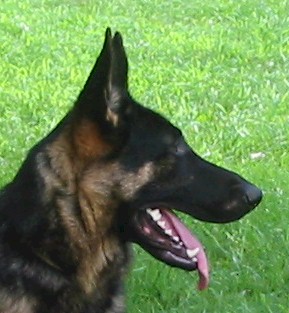German Shepherd Coat Colors and Types of Coats
People are always asking me about what different colors and
coats look like. I decided to put together a little
summary of the most common "traditional" coat colors. I am
not going to go into the different
non-traditional colors like "panda", "tricolors", "brindles",
etc.
To start with, one must understand that there
are patterns and colors. A pattern would be something like
a "sable pattern" but the color can vary from BLACK SABLE, RED SABLE, DARK
SABLE, etc. There are also "points" or "series" that can be found with
any color and I will try to find time to go over those too and a
later date.
|
PATTERNS |
COLORS |
COATS |
Sable
Saddle back
-
X-Small Saddle
-
Small Saddle
-
Average Saddle
-
Large Saddle
-
X-Large Saddle (Blanket)
Solid
Bi-Color
|
Sables:
-
Black Sable
-
Dark Sable
-
Medium Sable
-
Red Sable
-
Silver Sable
Saddles:
-
Black & Red
-
Black & Tan
-
Black & Cream
-
Black & Silver
Solids:
Bi-Color
Blue
|
Stock coat
Short/Flat coat
Plush coat
Long coat
|
The way that I am going to set this up is by
first going over COATS (because they are the easiest). Then we
will go over PATTERNS and COLOR together (sort of) because there are
actually different colors for each pattern. We will
conclude with different examples of COATS, COLORS. and PATTERNS.
Coats:
The Stock Coat:
Concerning the coat of the German Shepherd, the SV breed
standard states the following: "The normal (stock) coated
GSD should carry a thick undercoat and the outer coat should
be as dense as possible, made up of straight hard close
lying hairs. The hair on the head and ears, front of the legs, paws
and toes is short. On the neck it is longer and thicker, on
some males forming a slight ruff. The hair grows longer on
the back of the legs as far down as the pastern and the
stifle, and forms fairly thick
trousers on the hindquarters. There is no
hard or fast rule for the length of the hair, but short
mole-type coats are faulty."
- Short coated but with an
undercoat
- This is the preferred coat type
of the SV (German Shepherd Society of Germany)
The Short coat or Flat
Coat -
is an allowed coat length, and it's just what it sounds
like...short. The hair length is short and the coat lays
flat against the body.
These German Shepherds maintain a short
coat and usually have
less undercoat than that of the Stock Coat German Shepherd.
-
Short
coat with no undercoat
The Plush Coat:
is 'plushier' than the short coat, and is preferred more in
the show ring. It's basically a longer, fuller coat, yet
still an allowed length. Both the stock and plush coats have an undercoat. The
plush coat Shepherd has a medium length coat with
a thick, fluffy undercoat. These dogs do not have any
feathering as in the long coated GSD's.
- Medium
length coat with thick undercoat
- Preferred for show ring
The Long Stock Coat:
is a long coat that has an undercoat. This is not a desired
coat length despite the dog still having an undercoat.
Stock Coats shed just as much as their short or plush coated
counterparts The Long Stock Coat, like the normal Long
Coat, can be distinguished by long tufts, or 'feathering',
of hair on the ears and the backs of the legs and tail.
- Long coat with undercoat
- Feathering found on legs, ears,
and tail
The
Standard Long Coat:
is a long soft outer coat with no undercoat, and is a
fault as far as the standard is concerned. It has long
hair or feathering on the ears, legs, and tail.
The coated German Shepherd, also called
Long coated
German Shepherd's, have much longer fur around their
ears, on the backs of their legs, chest and tail
(feathering) than other German Shepherd's.
- Long coat with NO undercoat
- Feathering found on legs, ears,
and tail
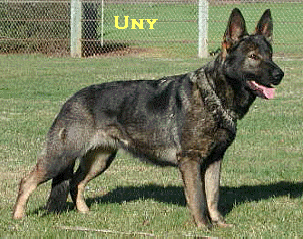
|
|
|
Coat: Stock Coat (on a working type
Czech female)
Pattern:
Sable
Color: Black Sable |
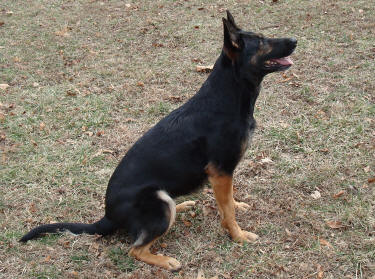 |
|
|
Coat: Short Flat Coat (on a working
type female)
Pattern:
Full Blanket
Color: Black/Red
|
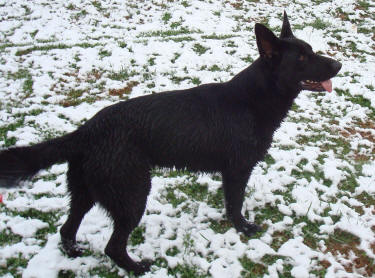 |
|
|
Coat: Plush Coat (on a DDR female)
Pattern:
Solid
Color: Black
|
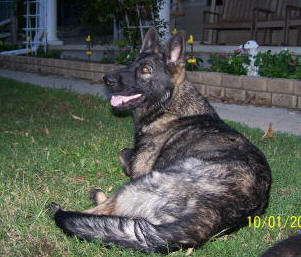 |
|
|
Coat: Plush Coat (on a DDR female)
Pattern:
Sable
Color: Dark to Black Sable
|
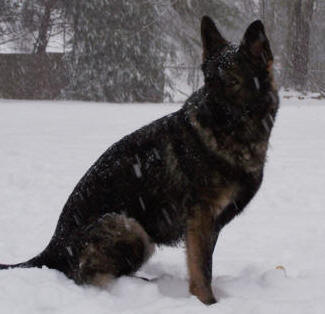 |
|
|
Coat: Plush Coat (on a DDR female -
same female as shown above with full winter
coat)
Pattern:
Sable
Color: Dark to Black Sable
|
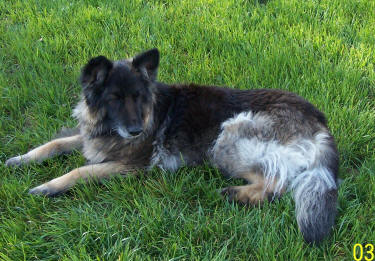 |
|
|
Coat: Long Stock Coat
Pattern: Large Saddle
Color: Black / Cream
|
|
|
|
|
|
|
More coming soon...... |
|
|
|
|
|
Patterns:
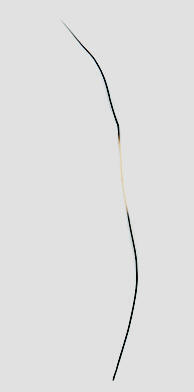 Sable pattern
(or Agouti) Sable pattern
(or Agouti)
- Sable pattern is the banding of color on the
dogs individual hairs, leaving a variety of shades and
colors available. A sable dog will have a
lighter undercoat (or undercolor) of grey, red, tan,
cream (undesirable), etc. and a "top coat" of black. This
color pattern is what most people refer to as "wolf-colored".
They have the guard
hairs with a black tips and a band of color the same shade as
their undercoats around the guard hair in various withes. This
band and black combination gives the hair and the dog its own
distinct color pattern. Viewed from a short distance, a
sable dog may appear black, grey or even black and tan. This allows sable dogs
come in a wide variety of colors and pigments. A typical sable guard hair showing the
banding that creates the distinctive
look is shown here at right 2x actual size.
- Sables are the most complex color
pattern.
-
Sable puppies are usually quite
dark at birth, become very light as they
lose their puppy coat, and then begin to
darken once again as their adult coat comes
in for the first time. As adults, sables
tend to change in appearance after each shed
and growth of a new coat. As a rule, they
become darker overall as they get older.
- When the dark top coat (guard
hairs) begin to fade, many breeders complain about the
timing. Often times the puppy begins to look "washed out"
about the time they are leaving for their new homes. Their
body color is usually the same as their undercoat color because the
"puppy" coat slowly begins to be
replaced by the "adult" coat. At this stage, these pups typically have a black
stripe down the back, black around the eyes, and a single black
ring around the tail. This bizarre color scheme is only around
for a
few weeks. The pups soon get progressively darker (and more
German Shepherd-like) until they finally reach their adult coat. No one can blame a novice for wondering if the breeder
is "on the level," or if some local Romeo didn't slip in and
visit "mom" in the dark of night. It is helpful if you have
several sable dogs about the place and their puppy pictures to
prove that this metamorphosis does in fact take place. But,
if you don't, the breeder is left in the rather pathetic
position of saying to the buyer, "Look, trust me. They get
darker!"
- How Dark Will They Get? The breeder usually has a pretty good idea of how dark
his/her sable pups will eventually become. After all, he/she has
seen the pups from birth. In my opinion, the blacker they
are at birth, the black they are as adults. Black sable pups are almost solid
black when born, then the color starts to fade. Red sables can
have a brilliant red undercoat, and are born a bit lighter, with
that black stripe already in evident (though it tends to be
spread over the shoulder blades as well)
- Most breeders that love sables
(me, included) like them "the darker the better". Some signs of exceptionally
dark pigment are black toes
("muddy feet" in the lingo), a black mask and black appearing on
the front of the leg running down towards the feet. The very darkest dogs are
called "black sables" and are considered highly desirable
because of the extremely dark pigment they possess. In my
experience, black sable dogs often carry the black recessive
gene, and can produce solid black puppies when bred to
another dog that carries the black recessive. The
blackest of Black sables
usually, in my opinion, have DDR (East
German) or Czech ancestry. The Czechs and East Germans
both bred from blacker dogs to walk the WALL (see
DDR History)
- Sable dogs can be used by a breeder to darken
the pigment of the next generation. Two sable dogs with similar
color will often have offspring that are darker than either parent.
-
Markings:
Often times, especially when referring to sables, you may hear
terms such as penciling, tar heels, striping, etc. These all
refer to the markings found on the dog. I will try to find
examples of these too and include them in the pictures below.
SaddleBack pattern - This
is the most well known (and possibly the most sought after) color in
American, especially by pet homes. The saddleback is
differentiated by the size of the black "saddle" on the backs of the
German Shepherd.
- "X-Small saddle" - have saddle
markings that take up a very small area in the center of the
back
- "Small saddle"
- "Standard Saddle"
- "Large Saddle"
- "Blanket Back"
-
have extended saddle markings that go roughly to the area of
their elbows, and give the appearance of a "blanket" rather
than a "saddle" on their backs.
Bi-colors -
are often defined as being predominantly black (or
blue/liver) with markings extending to the bottoms of their legs, and
sometimes above their eyes and around their muzzles.
It is
a pattern in which the 'saddle' covers most of the body,
leaving markings only on the LOWER legs / feet and sometimes
(usually) the face.
Solid pattern is exactly as it sounds - one color on
the entire body of the dog.
The solid pattern is a recessive gene, meaning it is only
expressed when the dog has 2 copies of the gene. Dogs that are
sable, black and tan, etc, can carry this gene without,
obviously, expressing it. Two solid
patterned dogs bred together can ONLY produce solid patterned
pups. There can be solid blacks, whites, blues, or livers
- It
should be mentioned here that dark pigment of eyes and coat is
highly desirable in the German Shepherd Dog. Some lines carry
the dilute gene which causes the coat to be washed out in color. White Shepherds carry the extreme form of the dilute gene, and
while they may be very lovely dogs, this lack of pigment is
considered undesirable according to the breed standard.
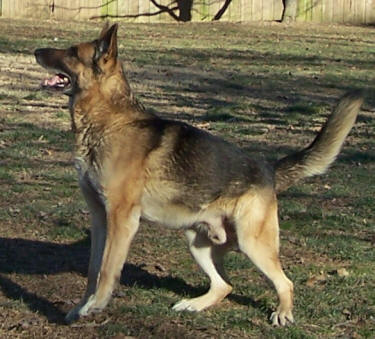 |
|
|
Most dominate coat pattern
Pattern: Sable
Pattern |
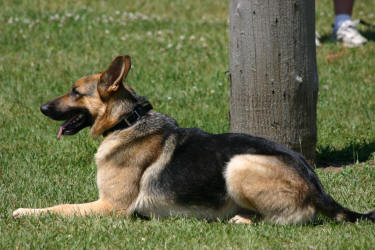 |
|
|
Second most dominate coat pattern
Pattern:
SaddleBack |
 |
|
|
Third
most dominate coat pattern
Pattern:
Bicolor |
 |
|
|
Most
recessive coat pattern
Pattern:
Solid
|
|
The
Basics on Genetics: For those who just can't get
enough.....
In the GSD, color genes are
dominant or recessive. This means that which ever
gene is dominant will determine the color of the pup.
Here is a dominance
chart - The Sable is the most dominate of the color genes and
the solid black is the least dominate.
|
Most Dominant |
Sable |
|
|
Black/Tan
(Saddleback) |
|
|
Bicolor |
|
Recessive |
Solid color -
Black |
Example:
The Saddle Back pattern is RECESSIVE to the Sable
pattern (also said that the Sable is DOMINANT to the SADDLE BACK). This means if two Saddle Back
dogs are bred, there can not be Sable pups, because
neither Saddle Back parent would carry the Sable gene
(otherwise they would be Sable). So, if one of the
parents is NOT a sable, there will be NO sables in a litter.
Also, another
factor to considered is that even though a dog may be
sable (because that is his most dominate color gene), he
can carry a BLACK/TAN gene as well. If he ONLY
carries one type of gene (meaning that both of his color
genes are the same), then he is considered g is
Homozygous. If he carries 2 different color genes, his is
considered Heterozygous
for a certain trait. There are at least 2 genes for
every trait - the color gene is a 2 gene trait. Homozygous
means that the dog only carries 2 of the SAME type of a gene for
certain trait, while Heterozygous
means that the dog carries 2 DIFFERENT genes for the same
trait.Example:
A Sable dog can be either Homozygous
or
Heterozygous Sable. This means he either carries 1 or 2 copies of
the sable gene. If the Sable dog had, for example, a
sable parent and a Saddle Back parent, that dog could
carry both of those genes - Sable, and Saddle back. The
dog would appear Sable since that is the
dominant
gene. This dog, in turn, could produce both Sables and
Saddle backs (depending on what color he is bred to), since he carries both genes. For a
Sable dog to be Homozygous Sable, it would have to have
2 copies of the sable gene. This would mean the dog
would have had 2 Sable parents that both passed the
sable gene on to it, and also that this dog can ONLY
produce sables. If he is heterozygous sable, he
can possibly produce a variety of colors. The chart below
shows what a breeding of a homozygous sable female and a homozygous
black/tan male would produce. The left side of the chart shows
what the genes of the puppy would be while the right side of the
chart show what the ACTUAL color of the resulting offspring would
be.
|
GENETIC MAKE-UP |
|
PHYSICAL TRAITS |
| Homogzygous |
Black / Tan |
Black / Tan |
= |
Phenotype |
Black / Tan |
Black / Tan |
| Sable |
S/BT |
S/BT |
= |
Sable |
Sable |
Sable |
| Sable |
S/BT |
S/BT |
= |
Sable
|
Sable
|
Sable |
-
Sables can carry any other color and
still be sables
-
A
homozygous sable
will always produce sable pups because it will
dominate all of the other possible genes the puppies
could inherit from the
other parent
-
Two
black and tans can never produce a sable since if
one of the parents had a sable gene to pass on, it
would itself be a sable
-
Two blacks can only produce blacks
Colors:
Most people who go shopping for a
German Shepherd Dog have a specific type of canine companion
anchored firmly in mind. Many purchasers are trying to
replace a dog that has passed on, or perhaps, seeking to
obtain a pup like the one they remember from childhood.
Whatever the reason, most folks who call us are looking for
a something in particular. Probably the most requested
color, for us, is the traditional black and tan dog.
What I find though, is that most people aren't really sure
exactly what they are looking for. For example:
People tell me that they want a classic black and tan
shepherd that looks like Rin Tin Tin - the problem with that
is that Rin Tin Tin was a sable.
Here are some color facts:
-
German Shepherd Black & tan or Black & red
puppies are born nearly all black
-
Colors continue to come
in for the first few years of their life.
-
The Solid Blacks ARE black
at birth and stay that way.
-
Sables themselves come in several colors - Red, Black, Dark,
Medium, etc. Sables end up with 'wolf' type
markings.
-
Black & red means the markings are darker
than the traditional tan... that is there is a reddish-brown tone to
the non-black color. This is the most popular color in Germany.
-
Black & cream is a lighter shade of tan
markings. Many people consider this a wash-out color of Black
and Tan and for most breeders this is considered less desirable.
-
Black & silver is often considered less desirable
as well, as the
grey
has 'washed out' until it is almost white. In my opinion this
is different than the "grey" in the sable pattern.
-
The color / pattern combination that is by
far the most known is the Saddle back pattern in the colors of Black
and Tan
There are some
other color genes that are less known (and typically less
desirable).
-
The Blue
Gene:
The blue gene is a (rare) recessive color gene - considered a
conformation fault. Both parents
of a dog must carry this gene for a pup to be blue. At
birth, dogs who are blue will be 'grey' or 'silver' in coloration, not the usual black. The blue gene is a
Dilute gene, meaning it dilutes all the black pigment of
a dog - Blue dogs will have grey nose leather (not
black), and
a grey 'dusted' appearance to their coats. The blue coloration can very from a very light 'powder' blue to
a very dark, almost indistinguishable 'steel' blue.
Blue dogs will also have very light colored eyes, often being
very blue at a young age, and as the dog grows, going
through varying shades of green and yellow, often ending
up yellow or a light shade of brown.
In other words,
all the black pigment of the dog appears in
shades
of blue/black instead of pure black. Most blues change
rapidly as they mature and many are hard to distinguish from
non-dilutes as adults.
-
The Liver Gene:
The Liver gene is also a recessive color gene
(rare - conformation fault). The Liver gene
blocks all black pigment, resulting in a dog that has brown nose
leather, and a brownish colored coat, instead of
black. The 'liver' coloration has a range of shades, varying from
a very light brown to a deep chocolate brown. Like the blues, liver
dogs also have light colored eyes of varying shades and also are caused by a
recessive color gene carried by both of the
parents. In this case, similar to the blues, all black
pigment is replaced with browns or liver colors of various
shades. Further, imagine a GSD dog that has brown nose
leather, and a brownish colored coat, where it would
normally be black in color. This 'liver' color comes
in a wide range of shades, varying from a very light brown
to a deep chocolate brown.
The LIVER COLOR comes as the result of
matched recessives in the black series and the BLUE COLOR happens as
the result of matched recessives in the dilution series BUT we will
discuss this later on ......
-
Whites:
The White German
Shepherds, contrary to some people's beliefs, are not albinos. The White gene is a
recessive gene, and it can be carried by colored dogs - ie. if two
black and tan dogs, which both carry the gene, are bred, there can
be some white puppies in the litter. Also, because of it's
recessive nature, 2 white dogs bred together can produce nothing but
white dogs, and a white dog bred to a colored dog who does not
carry the white gene can not produce any white dogs. There is a
long history behind the White German Shepherd but I will not go into
any of that because I am not involved with the white shepherd.
I do know of a couple of breeders who specialized in White
Shepherds so feel free to contact me for more information.
You can also find more info at the following link:
The American White
Shepherd Assocation
There seems to be several
major gene locations that determine the color and pattern of
a dog. At each of these locations from 2 to 6 versions
of the gene have been identified. Not all of these versions
are present in every breed, a fact that simplifies our
discussion of color in the German Shepherd Dog. The
ones that are actually playing the biggest role in GSD
colors are Agouti, Black, Color, and Intensity.
THE AGOUTI SERIES
- Up til now, what we
have been discussing has been this series. In most
discussions about GSD color this is the location (locus)
we are concerned about for most of the color
determination comes from this gene locus.
-
This series is
thought to contain six variations (or alleles)
- A
Dominant Black (not thought to
exist in GSD's - for if it was, then it was
dominate the sable gene).
- ay
Golden a rarely seen version of sable.
"ay" would also be called agouti.
- aw
Gray or Red what we usually call
sable in GSD's
- as
Saddle our common black and tan GSD's
(with the variations in tan color controlled by
the intensity series below).
- at
Bi-Color A better term for this
(and one that would be more consistent with
other breeds) would be tan point
- a
Recessive Black - the only form
of black that exists in the GSD.
At each locus (in this
case, the AGOUTI locus) a dog carries two genes.
It inherits one of those genes from its sire and the
other from its dam. If a dog inherits an "a"
(or recessive black) from each of its parents it
will be a black. If it inherits an "a" from
one parent, and anything else from the other parent,
it will be that other "color". So, a dog that
has an "a" and an "as" will be a saddle (or black
and tan). A dog with an "a" and an "aw" will be a
sable. In other words:
| Gene Combinations and
the Resulting Coat Color:
Genotypes and Phenotypes of Coat
Colors |
|
Sables |
Black and Tan |
Bicolors |
Blacks |
|
aw + a =
sable |
as + a = black and
tan |
at + a =
bi-color |
a + a = black
|
|
aw + at =
sable |
as + at =
black and tan |
at + at =
bi-color |
a + at =
bi-color |
|
aw + as =
sable |
as + as =
black and tan |
at + as =
black and tan |
a + as =
black and tan |
|
aw + aw =
sable |
as + aw =
sable |
at + aw =
sable |
a + aw =
sable |
-
I left
"A" and "ay" out of the chart - they are
rare, if not non-existent, in German
Shepherds.
THE BLACK SERIES
- The BLACK
series --This locus controls the ability to produce
black pigment in the coat and skin (nose,
pads, etc.) not the hair
color.
- B
Black pigment - this allele creates
the black in the coat or skin. This is the
most common in GSD's.
- b
Liver Pigment - this allele creates
dogs with no black in their coat or skin
(they have brown hair, noses, and pads).
Commonly called "Livers".
- It should be clear, from the fact that this
factor is controlled by genes at an entirely
different location, that you can have a
liver that is genotypically a black, a
bi-color, an black and tan, or a sable.
These livers will look somewhat different
from one another, since what has been
effected is the black pigment and the black
pigment is distributed differently in each
of those patterns.
THE COLOR SERIES
- This is the series that
determines the look of the white is ALL breeds
- White coat color in
the German Shepherd Dog is recessive and also
completely independent of the genes needed to produce
sables, bicolors, black/tan or solid patterns in
colored GSDs. White coat color is also totally
independent of either of the blue or liver dilution
genes found in the German Shepherd Dog breed.
- C
Color Factor : most common in GSD's -
causes sables, black and tans, bicolors, and black.
- cch
Chinchilla: not confirmed in GSD's,
- cd
White: leads to white coated, dark
eyed dogs with black noses and pads.
- cb
Cornaz: leads to white coated, blue
eyed dogs (not thought to exist in GSD's).
- c
Albanism: leads to white
coated, pink nosed dogs.
- The white gene masks the
genetic coat pigment of the German Shepherd coat
colors, although it does not affect skin pigment.
A good white GSD should have both dark eyes and a black
nose and lips.
- In order to get a
white coat color in the German Shepherd, both parents
must carry the white gene (they must either be
white
dogs
themselves or be carriers of the white gene). The order
of dominance is as follows: Melanin is produced.
(Standard GSD colors have this); Partial albinism (not
seen); White coat with dark eyes and nose (not albino);
Yellowish coat collar.
THE INTENSITY
SERIES
- Controls the intensity of the non-black coloration.
The order of dominance is as follows: Lightest tan (cream);
Intermediate tan (tan); Darkest tan (red).
- The INTENSITY series
determines whether GSD's with color will be black & cream, black & tan or
black & red. In other words: These
alleles lead to our "black and creams", "black and
tans", "black and reds", and the common variations in
sables.
- INT:
Lightest tan (cream).
- intm:
Medium tan tan.
- int: Darkest
tan red.
THE DILUTION SERIES
- The effect of these
alleles depends on what you have at other locations.
It directly affects the BLACK SERIES
- This controls how intense the black pigment will appear
on your German Shepherd. The order of dominance is as
follows: Dense pigment; blue dilution.
- Black pigment combined with blue dilution will produce a
blue coated German Shepherd which looks as though it has a
dusty or flour sheen to it.
- D
No Dilution: no
effect.
- d
Dilution
black: "B" becomes blue and liver "b" becomes
fawn. Results in an overall loss of color
intensity.
A typical bd
dilution - commonly called fawns
A typical Bd
dilution - commonly called a blue
THE MASK SERIES
or EXTENSION series
- This controls whether or not a mask appear on your German
Shepherd. The order of German Shepherd Coat Colors dominance
is as follows: a black mask on the face; dark coat with no
mask; Brindle (rare, will be seen as striping on the legs);
clear tan.
- Em
Black Mask: most common in GSD's.
- E
No Black Mask: does apear in GSD's sometimes.
- ebr
Brindle: rare or non-existent in GSD's.
- e
Fading: causes
black to fade over time and is rare.
GRAYING SERIES
- G
Graying: born black, turns blue, not thought
to exist in GSD's.
- g
Non Graying: born black, stays black.
All GSD's are thought to be "g".
MERLE
SERIES
- M
Merle: seen in Collies, Aussies, Cattle Dogs
- mottled grey, black, tan, often with blue or
mismatched eye color.
- m
Non-Merle: all GSD's are non-merle.
SPOTTING SERIES
- S
Solid Color: all GSD's seem to be "S".
- si
Irish Spotting
- sp
Piebald
- sw
Extreme White Piebald
TICKING SERIES
- T
Ticking
- t
Non Ticking: all GSD's seem to be "t".
All these genes put together determine your own German
Shepherds coat colors.
Color
Facts -
In Germany it is generally accepted that there are two
varieties of German Shepherd Dog - the WORKING dog and the SHOW
dog. The working lines have been bred primarily
to excel in Schutzhund sport and many, MANY of the famous "working lines"
are Grey or sable. Schutzhund
sport demands a fit body, sound mind, and good hips. There are
also German dog bred to excel in the show ring. These dogs have
"high lines" or "show lines." Many of them are black and tan or
black and red. High line dogs are also required to pass a Schutzhund trial, but once titled, show dogs usually leave the
Schutzhund field behind. Of course, the best of both
worlds is a beautiful show dog that works well.
While this is certainly possible, it doesn't happen
often. However, my experience is
that many of the best working bloodlines carry the sable/grey
gene.
Why Are So Many Good Working Dogs Sable? We may never know all the facts
but it is said that the sable color was never very popular
in Germany. As a result, the sable dog had to be very good in
order to get any breedings. So, as a result, the sable dog
is often consider to be (or was) a better working
dog. With that coat color being more dominant
but few people liked it, the dog had to be darn good
for some to want to bred to it. Even
today the sable dog is more often seen in the
working lines while the black and red is still
preferred for the show ring.
Concerning German Shepherd coat colors, the breed
standard from the SV specifically states: "The color of the
GSD is in itself not important and has no effect on the
character of the dog or on its fitness for work and should
be a secondary consideration for that reason. The final
color of a young dog can only be ascertained when the outer
coat has developed."
Of all undesirable things to try to eliminate and to
consider in a
German
Shepherd Dog, coat color should be at the
BOTTOM of
the list. Good pigment should be sought after but many
factors such as health and temperament, to name a few,
should be much more important than coat color which should
always be subordinate to structure, gait, type, and
character and should never take precedence over the working
ability of the dog. Eye color should be dark and nose
pigment should be black as well.
In
conclusion: There is nothing wrong with having a color preference when
shopping for a pup. There are many German Shepherd breeders in
this country and a buyer has a host of colors to choose from. But, there is a great deal more to breeding a good dog than
shooting for your favorite color.
"No good dog is a bad
color" -- Max von Stephanitz
(breed founder of the German Shepherd Dog)
concerning German Shepherd coat colors
|
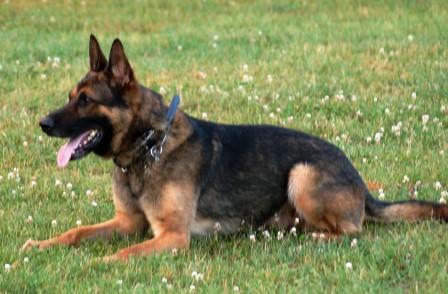 |
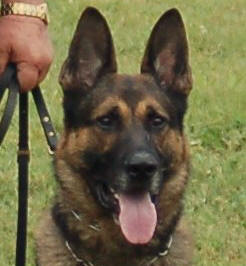 |
|
Coat: Stock Coat
Pattern:
Sable
Color: Red Sable |
|
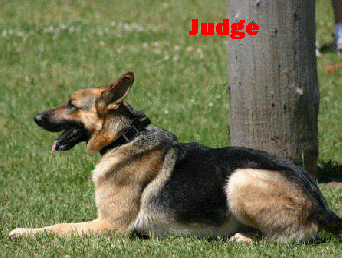
|
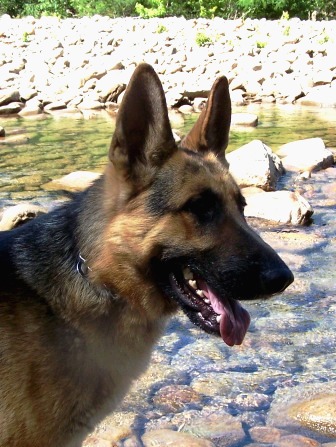 |
|
Coat: Stock Coat
Pattern:
Saddleback w/ Large Saddle
Color: Black / Tan |
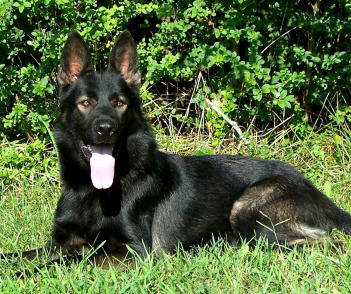 |
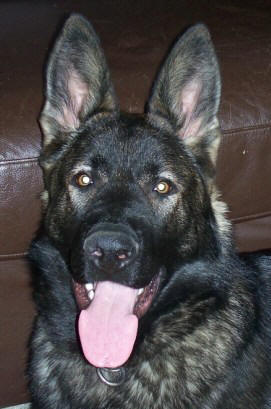 |
|
Coat: Stock Coat
Pattern:
Sable
Color: Black Sable |
|
 |
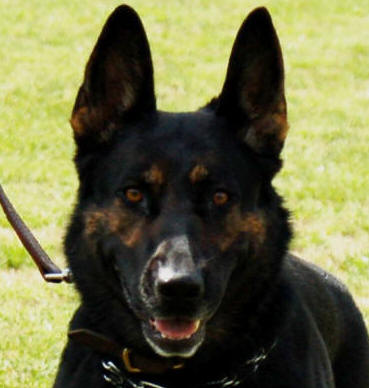 |
|
Coat: Flat Coat
Pattern:
Saddleback with Blanket
Color: Black / Tan
|
|
 |
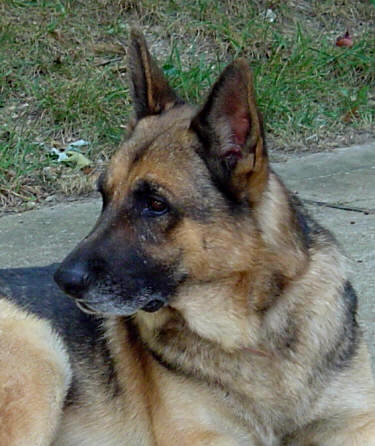 |
|
Coat: Plush Coat
Pattern:
Sable
Color: Medium Sable |
|
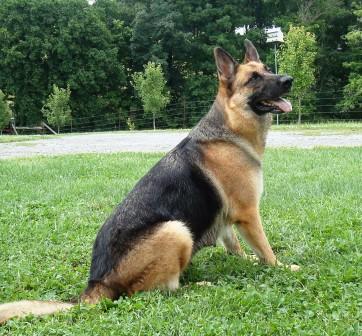 |
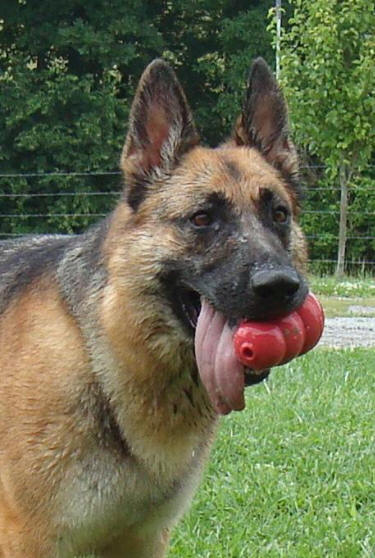 |
|
Coat: Stock Coat
Pattern:
Saddleback w/ Large Saddle
Color: Black / Tan |
|
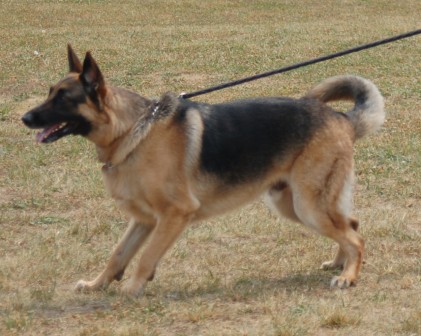 |
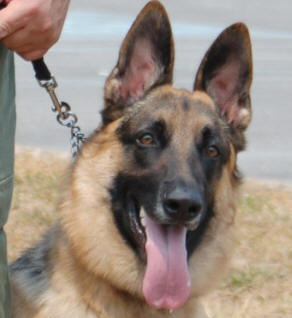 |
|
Coat: Stock Coat
Pattern:
Saddleback w/ Medium Saddle
Color: Black / Tan |
|
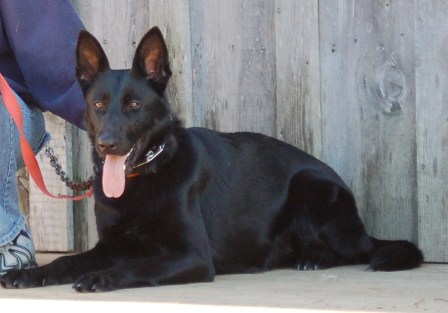 |
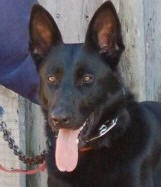 |
|
Coat: Flat Coat
Pattern:
Solid
Color: Black |
|
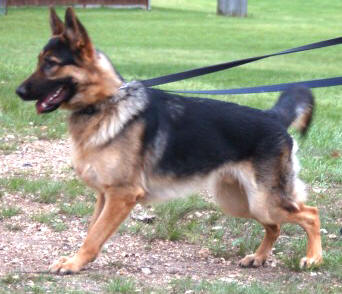 |
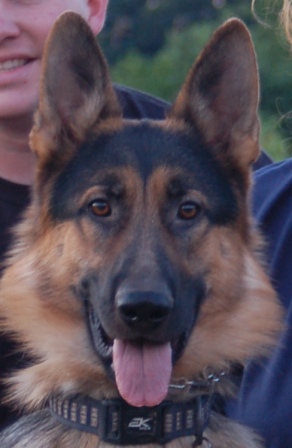 |
|
Coat: Plush Coat
Pattern:
Saddleback w/ large Saddle
Color: Black / Red |
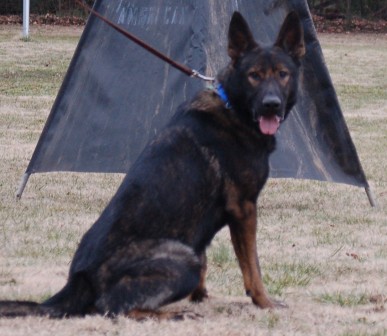 |
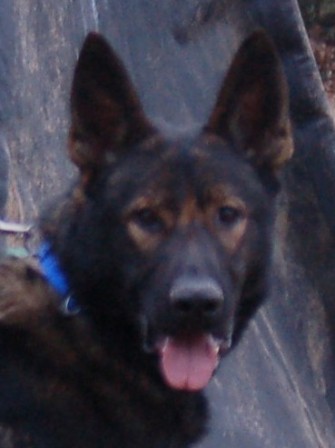 |
|
Coat: Stock Coat
Pattern:
Sable
Color: Black Sable |
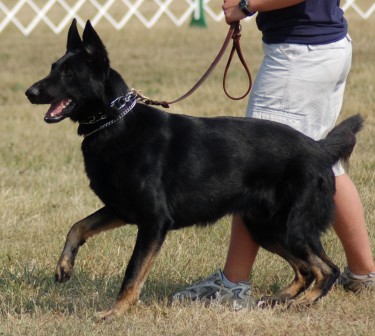 |
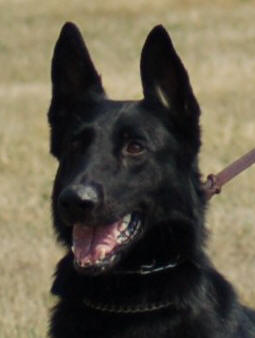 |
|
Coat: Stock Coat
Pattern:
Bicolor
Color: Bicolor |
|
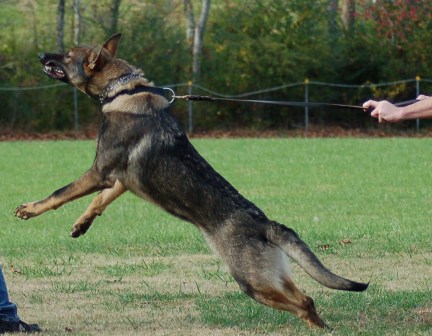 |
|
|
Coat: Stock Coat
Pattern:
Sable
Color: Dark Sable |
|
 |
|
|
Coat: Stock Coat
Pattern:
Saddleback w/ x-large Saddle
Color: Black / Tan |
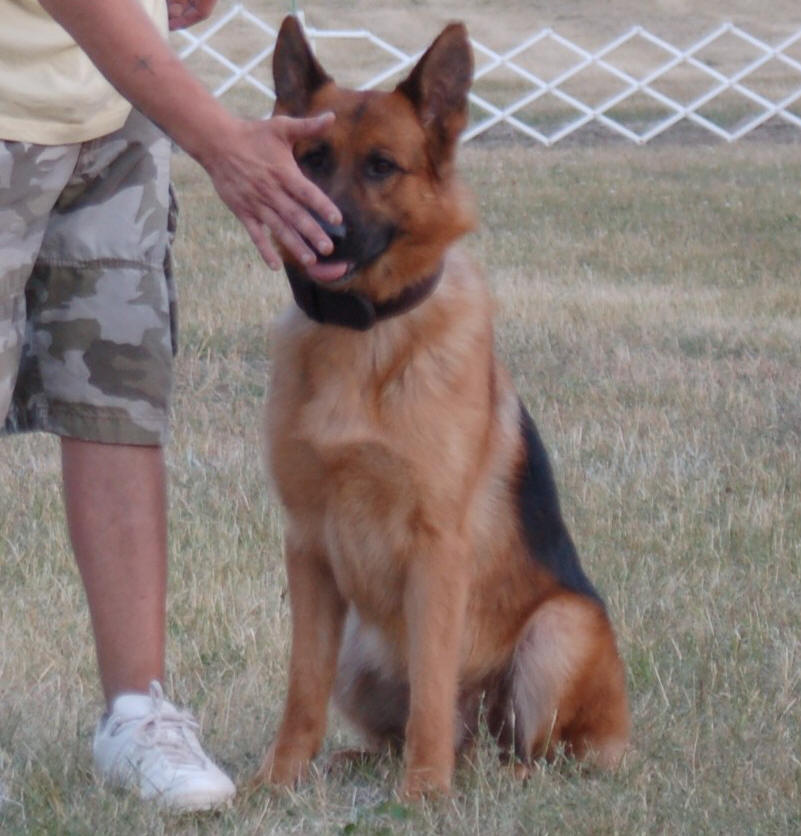 |
|
|
Coat: Plush Coat
Pattern:
Saddleback
Color: Black and Red |
| |
|
|
|
|
More coming
soon......... |
|
|
|
|
|
|
